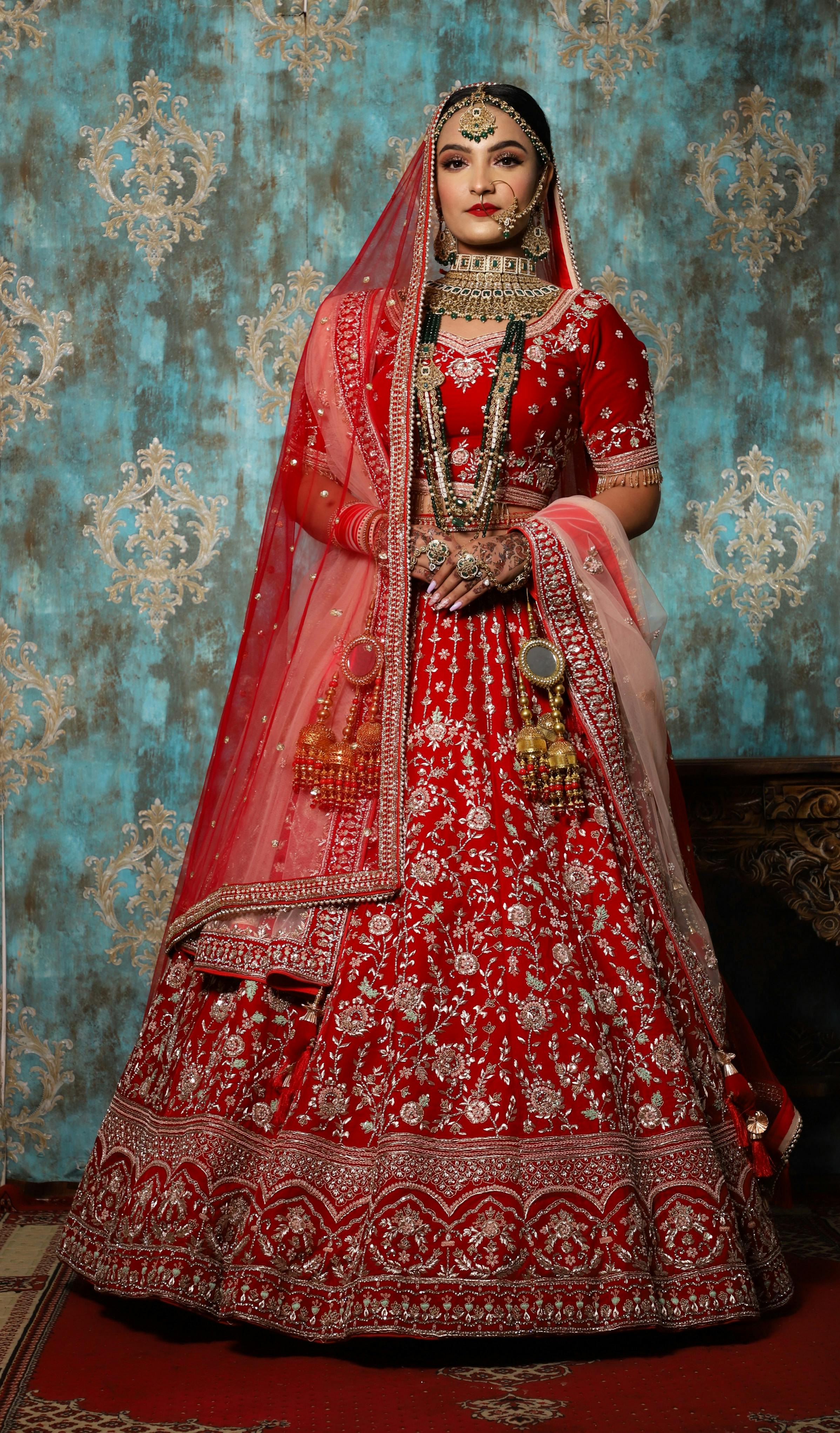In North India, weddings are not just a celebration of two people coming together, but a grand affair that involves days of festivities and deeply-rooted traditions. One of the most important elements of any North Indian wedding is the attire. The bride and groom are the center of attention, but the wedding guests also dress in their finest traditional outfits.
For the bride, the wedding dress is the epitome of beauty and grace. Traditional North Indian bridal attire is intricately designed, rich in colors, and adorned with exquisite embroidery and embellishments. The bride is the star of the show, and her dress is a reflection of her personality, culture, and traditions. The North Indian bridal dress has evolved over the years, but it still incorporates the essence of the region’s rich cultural heritage.
The traditional bridal dress in North India varies from region to region, but the main elements remain the same. The dress is known for its elaborate silhouette, which is influenced by the Mughal era. The attire is a combination of a long tunic, known as a lehenga, and a dupatta, which is a long scarf that is draped over the head and shoulders. The lehenga is usually heavily embellished with intricate embroidery, zari (gold thread), and zardozi (metallic threadwork).
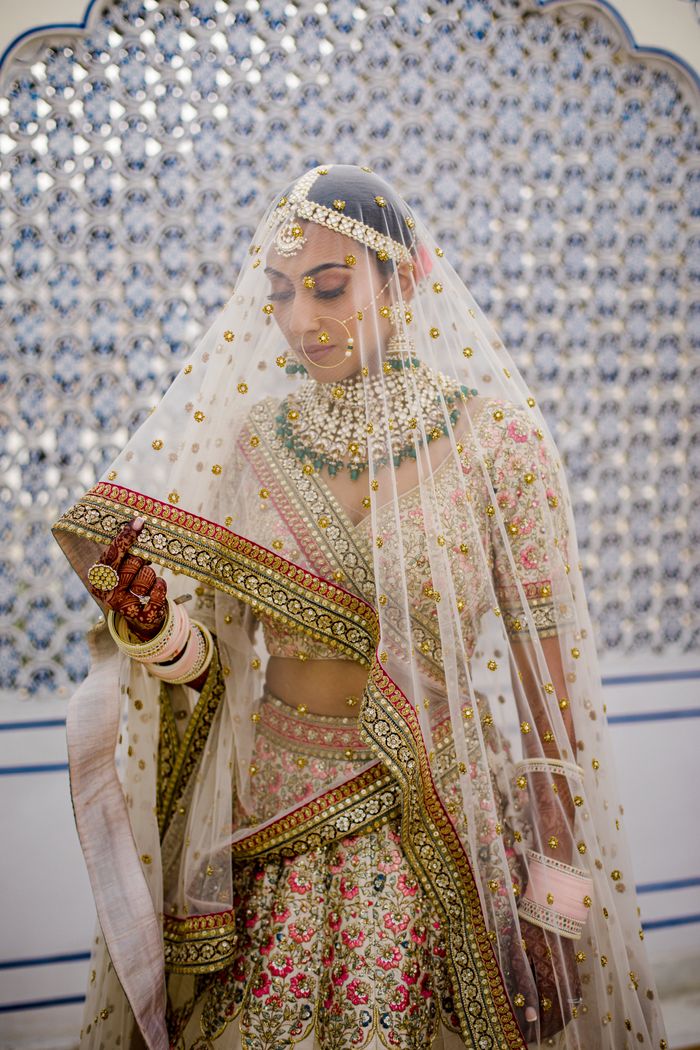
The dupatta is a crucial part of the bridal attire and is draped over the head, covering the bride’s face during the wedding ceremony. The color of the dupatta varies depending on the region, but red is the most popular color for a North Indian bride. Red signifies love, passion, and commitment, and is considered an auspicious color in North Indian weddings. The dupatta is also adorned with embroidery, beads, and sequins, which add to the bride’s overall look.
Apart from the lehenga and dupatta, the North Indian bridal dress also includes various other accessories. The bride wears heavy gold jewelry, including a necklace, earrings, bangles, and a maang tikka (a jewelry piece that covers the forehead). The jewelry is often family heirlooms and has been passed down from generation to generation. The bride also wears intricate henna designs on her hands and feet, which symbolize good luck and prosperity.
It’s not just the bride who dresses in traditional attire for a North Indian wedding. The groom also wears a Sherwani, which is a long coat-like garment that is paired with pajama bottoms. The Sherwani is made from luxurious fabrics such as silk, velvet, or brocade and is also adorned with embroidery and embellishments. The groom also wears a turban, which is an important aspect of the North Indian culture and symbolizes honor and respect.
In conclusion, the traditional North Indian wedding dress is a reflection of the region’s rich cultural heritage and diversity. The attire is ornate, elaborate, and heavily embellished; emphasizing the importance of the celebration. From the bride’s lehenga and dupatta to the groom’s Sherwani, each element of the attire has significant cultural and symbolic value. The North Indian bridal dress is a true work of art, and it’s not just a dress, it’s an expression of love and tradition.
The Significance of the Wedding Dress
North Indian weddings are known for their grandeur and are a symbol of the traditions, beliefs, and culture of their respective communities. One of the most significant aspects of any Indian wedding is the attire of the bride and groom. The wedding dress is not just a piece of clothing but is an embodiment of the cultural roots of the families involved. The North Indian wedding dress is an elaborate and stunning ensemble that is a visual delight.
The Bridal Lehenga
The North Indian bride’s dress is usually a lehenga choli, a three-piece ensemble that includes a long skirt, a short blouse, and a scarf or dupatta. The lehenga can vary in length, being either ankle or floor-length. The skirt is adorned with intricate embroidery, beadwork, sequins or stones, and is usually made with luxurious fabrics such as silk or velvet.
The Bridal Lehenga is a central and significant aspect of a North Indian wedding. The Bridal Lehenga holds deep cultural and symbolic value, representing the traditions and heritage of the region. Let’s look at different aspects of bridal lehenga:
-
Significance: The Bridal Lehenga is an embodiment of the bride’s cultural roots and is considered a visual delight. It is a reflection of love, purity, fertility, and prosperity. The color red, commonly used in Bridal Lehengas, symbolizes these values. However, other colors such as pink, gold, green, and blue have also become popular in recent times.
-
Types of Bridal Lehengas: There are various types of Bridal Lehengas including A-line Lehengas, Mermaid Lehengas, Flared Lehengas, Straight-cut Lehengas, and more. Each style has its own unique silhouette and can be chosen based on the bride’s body type and personal preference.
A-line Lehenga: The A-line Lehenga is a popular choice among brides. It features a fitted waistline that gradually flares out in an ‘A’ shape, resembling the letter ‘A’. This style suits most body types and provides a flattering silhouette. The A-line Lehenga is versatile and can be adorned with various embroidery and embellishments.
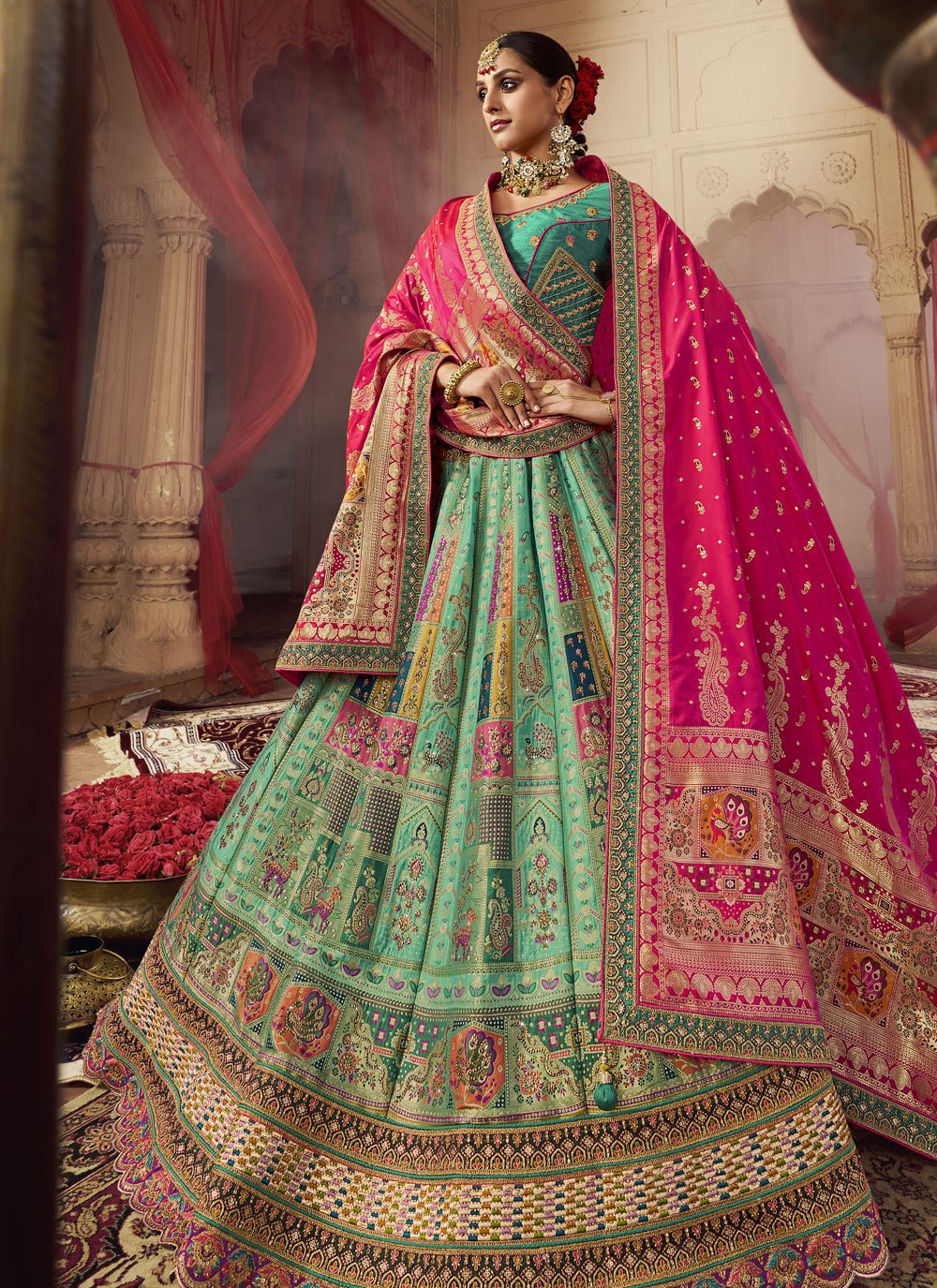
Mermaid Lehenga: The Mermaid Lehenga, also known as the fishtail Lehenga, is fitted till the knees and then flares out dramatically towards the bottom, resembling the shape of a mermaid’s tail. This style accentuates the curves and adds a touch of glamour to the bridal ensemble. It is typically made with fabrics that have good draping qualities, such as silk or georgette.
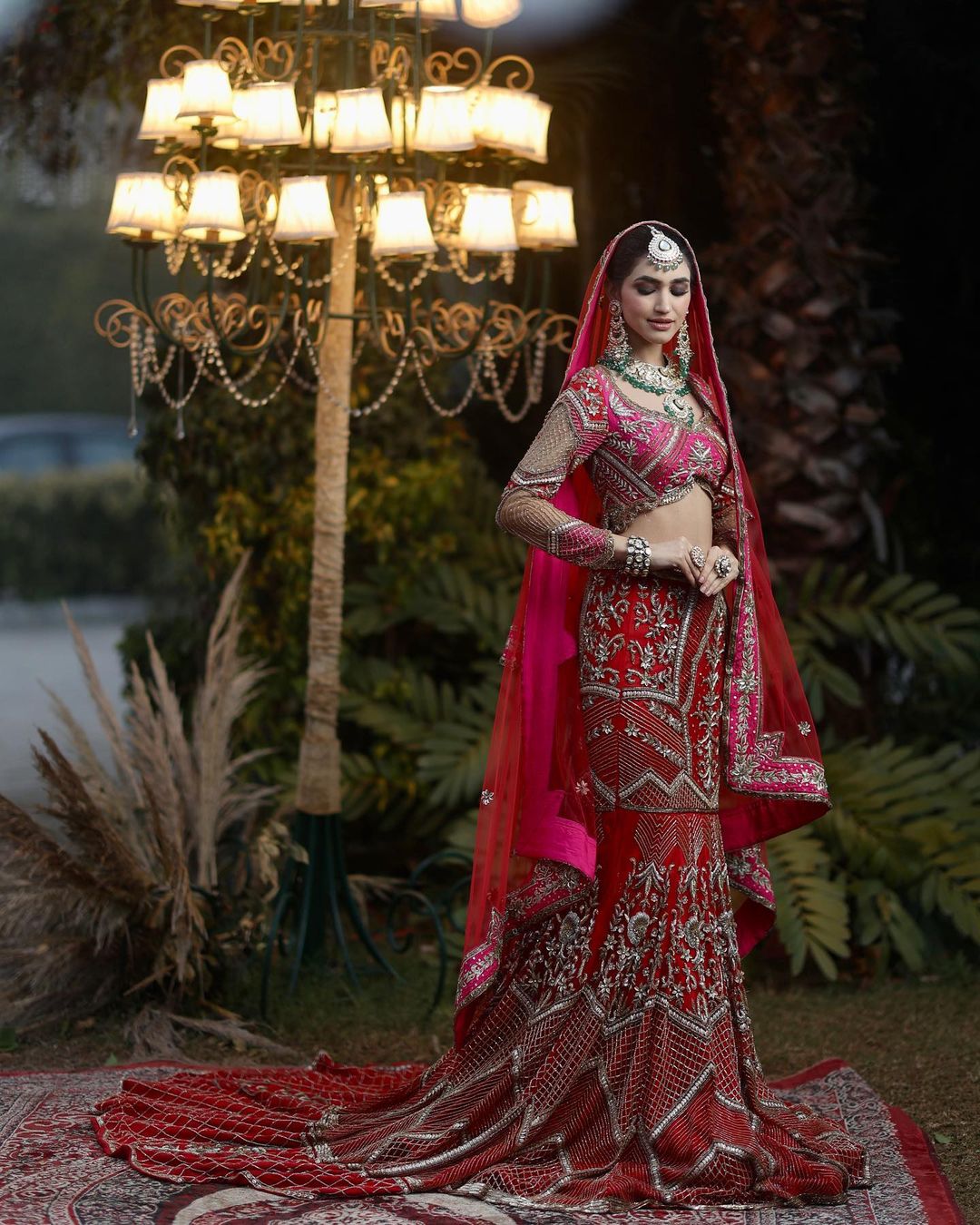
Flared Lehenga: The Flared Lehenga, also referred to as the circular Lehenga, has a voluminous skirt that forms a complete circle when spread out. It creates a regal and majestic look, perfect for traditional North Indian weddings. The Flared Lehenga is often crafted with multiple layers of fabric to create the desired volume and flare.

Straight-cut Lehenga: The Straight-cut Lehenga features a skirt that falls straight from the waist without any flare or volume. This style offers a sleek and sophisticated look. It is suitable for brides who prefer a more minimalistic and contemporary approach to their bridal attire. The Straight-cut Lehenga can be embellished with intricate embroidery or paired with a heavily embroidered blouse for contrasting details.

Panelled Lehenga: The Panelled Lehenga consists of multiple horizontal panels stitched together to create a layered effect. Each panel can be of a different fabric, color, or pattern, adding visual interest to the Lehenga. The panelled design allows for experimentation with contrasting fabrics and textures, making it a unique and eye-catching choice.
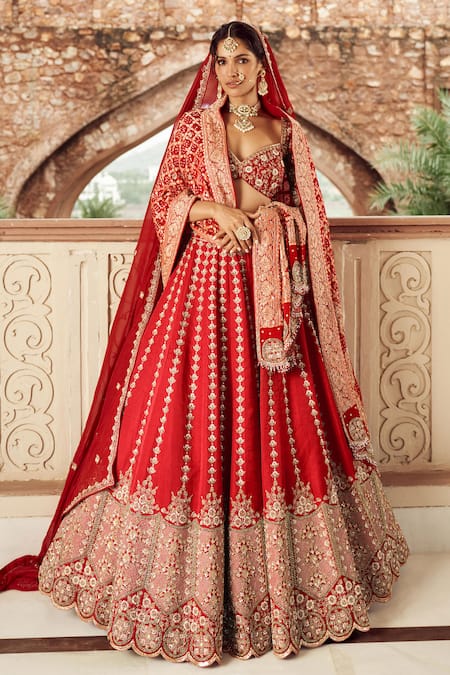
Jacket Lehenga: The Jacket Lehenga combines the traditional Lehenga skirt with a long jacket or cape-style top. The jacket can be heavily embellished or intricately embroidered to create a statement look. This style offers versatility as the jacket can be removed or added based on the bride’s preference and the occasion’s requirements.

Sharara Lehenga: The Sharara Lehenga is a fusion of Indian and Islamic styles. It features a flared skirt paired with loose-fitting pants called sharara. The sharara pants are usually heavily embellished, while the skirt may have a simpler design. This style adds an element of uniqueness and elegance to the bridal ensemble.

Trail Lehenga: The Trail Lehenga is known for its extended length at the back, creating a train-like effect as the bride walks down the aisle. This style exudes grandeur and opulence, making it a popular choice for elaborate weddings. The trail can be detachable or attached to the main skirt, depending on the bride’s preference.
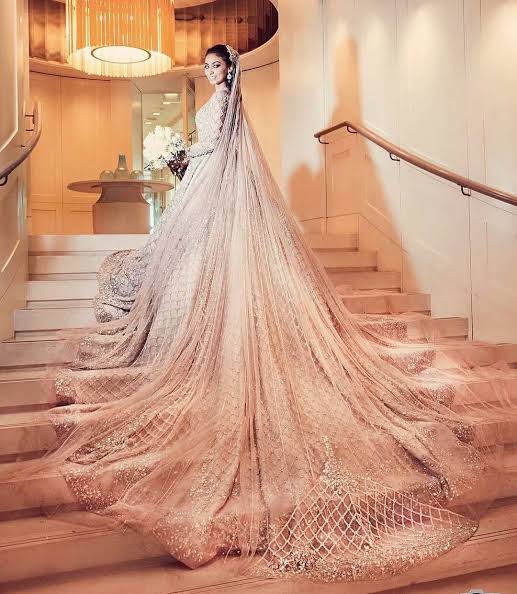
Each type of Bridal Lehenga offers its own distinct style and appeal. Brides can choose the one that best suits their body type, personal preference, and the overall theme of their wedding.
-
Fabric and Embellishments: Bridal Lehengas are typically made with luxurious fabrics such as silk, velvet, or brocade. These fabrics add richness and elegance to the attire. The skirt of the Lehenga is adorned with intricate embroidery, beadwork, sequins, or stones. These embellishments enhance the beauty of the Lehenga and make it stand out.
-
Care Tips: Storing the Lehenga in a breathable garment bag and avoiding direct sunlight can help preserve its colors and fabric quality.
Proper storage: After the wedding festivities, it is important to store the Bridal Lehenga properly to maintain its beauty and quality. Store the Lehenga in a breathable garment bag or a muslin cloth to protect it from dust, moisture, and insects. Avoid using plastic covers as they can trap moisture and potentially damage the fabric.
Avoid direct sunlight: Exposure to direct sunlight can cause the colors of the Bridal Lehenga to fade over time. It is advisable to store the Lehenga in a cool, dry place away from sunlight. If you need to air out the Lehenga, do so in a shaded area.
Avoid heavy items on top: When storing the Bridal Lehenga, make sure to avoid placing heavy items on top of it. This can lead to wrinkles, creases, or even damage to the delicate embroidery and embellishments. Keep the Lehenga in a dedicated space where it won’t be crushed or flattened.
Professional cleaning: If your Bridal Lehenga gets stained during the wedding festivities, it is recommended to take it to a professional dry cleaner with experience in handling delicate and heavily embellished garments. They will have the expertise to clean the Lehenga without causing any damage. Avoid attempting to clean it yourself as you may inadvertently damage the fabric or embroidery.
Handle with care: When handling the Bridal Lehenga, do so with clean hands to avoid transferring oils or dirt onto the fabric. Be cautious while wearing heavy jewelry or accessories that may snag or pull at the delicate embroidery. If you need to move or adjust the Lehenga, do it gently to avoid any tears or damage.
-
Carrying Tips: Wearing a Bridal Lehenga requires some skill to carry it gracefully throughout the wedding festivities.
Dupatta draping: The dupatta is an essential part of the Bridal Lehenga and needs to be draped elegantly over the head and shoulders. Practice draping the dupatta before the wedding day to ensure a comfortable and secure fit. Use safety pins discreetly if needed to keep the dupatta in place.Manage skirt volume: Bridal Lehengas often have voluminous skirts, which can be challenging to manage while walking or sitting. Hold the skirt slightly above ground level while walking to avoid stepping on it or tripping. When sitting down, arrange the skirt around you in a way that allows you to sit comfortably without putting unnecessary pressure on the fabric.
Comfortable footwear: Choose footwear that complements your Bridal Lehenga while providing comfort throughout the wedding festivities. Consider wearing wedges or flats instead of heels if you anticipate a lot of walking or standing. This will help you feel more at ease and confident while carrying yourself gracefully.
Practice movement: Before the wedding day, practice moving around in your Bridal Lehenga to get accustomed to its weight and volume. Practice walking, sitting, and even dancing if possible. This will help you feel more comfortable and confident during the actual event.
The Significance of the Color Red
The color red is seen as auspicious in Indian culture and is commonly used in wedding clothes. The bridal lehenga is usually in shades of red, symbolizing love, purity, fertility, and prosperity. However, the use of other colors such as pink, gold, green, and blue has also become popular in recent times.
The Groom’s Sherwani
The groom’s attire is usually a sherwani, a long coat worn over a kurta and churidar. The sherwani is detailed with intricate embroidery, beadwork or stone work and is accessorized with a turban or safa, a pair of jutti, and a stole.
The Groom’s Sherwani holds great significance in a North Indian wedding. The Sherwani is not just a piece of clothing; it is a symbol of honor, respect, and cultural heritage. Let’s look at the different aspects of the Groom’s Sherwani:
-
Significance: The Sherwani is considered a regal and elegant attire for the groom. It represents tradition, masculinity, and sophistication. The groom’s Sherwani is often intricately designed with embroidery, beadwork, or stone work, showcasing the craftsmanship and attention to detail. It is a reflection of the groom’s personality and adds a touch of grandeur to the wedding ensemble.
-
Different Types of Sherwanis: There are various types of Sherwanis that groom can explore. Some popular types include:
-
Traditional Sherwani: The traditional Sherwani usually features a long coat with a high collar and full sleeves. It is typically made from luxurious fabrics such as silk, velvet, or brocade. The traditional Sherwani is known for its intricate embroidery and embellishments, often inspired by Mughal and Persian designs.
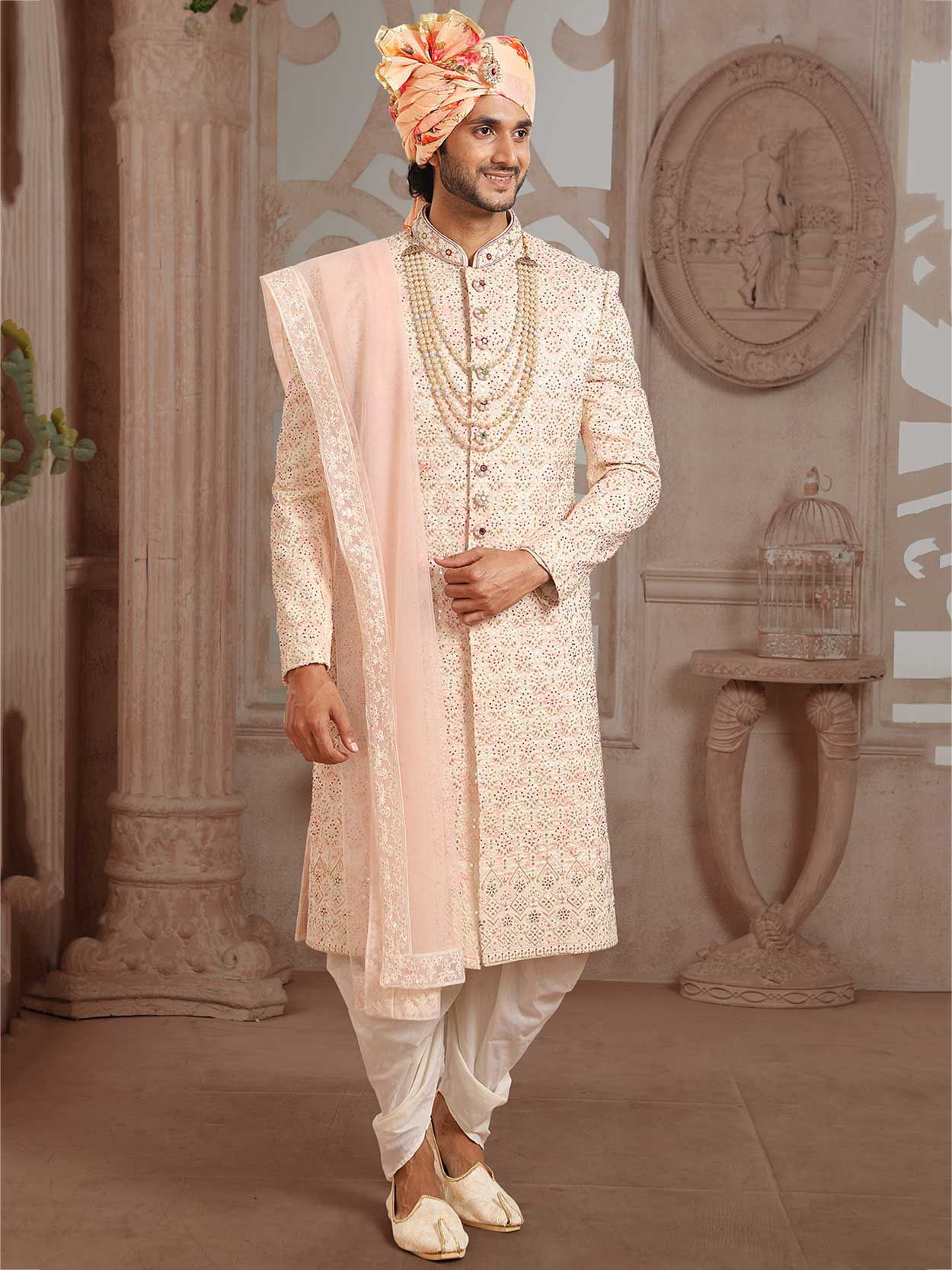
-
Jodhpuri Sherwani: The Jodhpuri Sherwani originated in the royal courts of Rajasthan. It is characterized by its structured silhouette, shorter length, and a Nehru collar (also known as a Mandarin collar). The Jodhpuri Sherwani is often adorned with buttons and intricate embroidery, giving it a royal and sophisticated look.
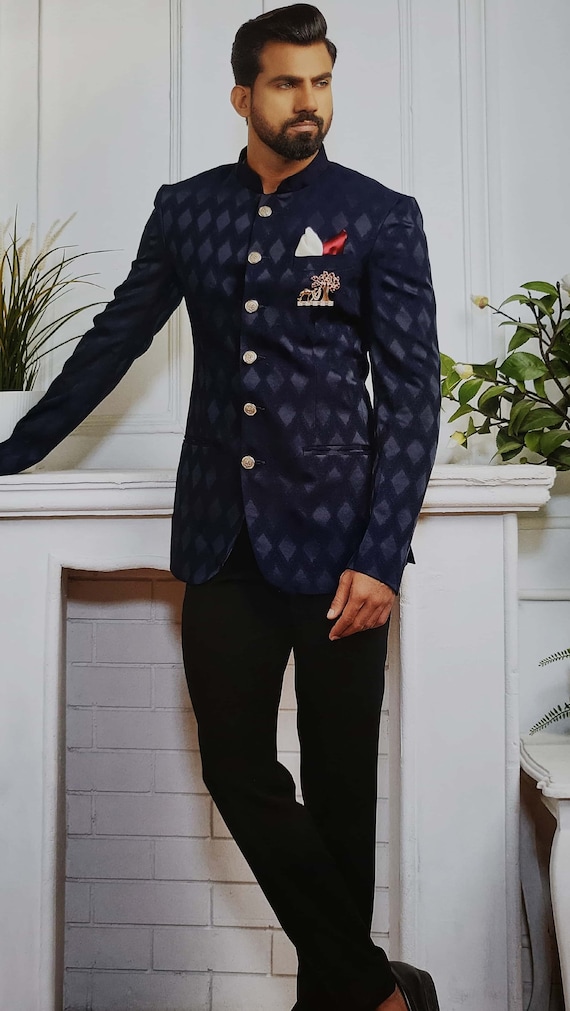
-
Indo-Western Sherwani: The Indo-Western Sherwani is a fusion of Indian and Western styles. It combines the traditional elements of a Sherwani with contemporary cuts and designs. This style often incorporates Western-style collars, asymmetrical cuts, or unique fabric combinations, offering a modern twist to the traditional attire.

-
-
Care Tips: To ensure that the Groom’s Sherwani remains in pristine condition, it is essential to provide care tips. These can include:
-
Dry Cleaning: Due to the intricate embroidery and delicate fabrics used in Sherwanis, it is recommended to take them to a professional dry cleaner for cleaning. They have the expertise to handle such garments without causing any damage or discoloration.
-
Proper Storage: After the wedding festivities, store the Sherwani in a breathable garment bag or a muslin cloth. Avoid using plastic covers as they can trap moisture and potentially damage the fabric. Store it in a cool, dry place away from direct sunlight to prevent color fading.
-
-
Carrying Tips: Wearing a Sherwani requires some skill to carry it with grace and confidence.
-
Proper Fittings: The key to carrying a Sherwani with grace and confidence is to ensure that it fits the groom perfectly. A well-fitted Sherwani enhances the groom’s overall look and allows for ease of movement. The shoulders, sleeves, and length should be tailored to the groom’s measurements, providing a comfortable and polished appearance. It’s essential to have the Sherwani tailored by a skilled professional to achieve the ideal fit.
-
Coordinate with Accessories: Pay attention to coordinating accessories such as the dupatta, safa (turban), and footwear with the Sherwani. The dupatta should be draped elegantly, and the safa should complement the color and design of the Sherwani. Footwear, such as traditional juttis or mojaris, should be comfortable and complement the overall look.
-
Posture and Confidence: Carrying a Sherwani with elegance also involves maintaining good posture and exuding confidence. The groom should stand tall with shoulders relaxed and back straight. Confidence in one’s appearance enhances the overall impact of the Sherwani ensemble.
-
Practice Movement: Before the wedding day, it is beneficial for the groom to practice moving around in the Sherwani. This includes walking, sitting, and performing any ceremonial rituals. Practicing movement helps the groom become accustomed to the weight and feel of the Sherwani, allowing for a more natural and confident posture during the actual event.
-
Comfortable Lining: The inner lining of the Sherwani plays a crucial role in ensuring comfort throughout the wedding festivities. It should be made of breathable fabric to prevent discomfort due to perspiration. The lining should also be smooth and well-fitted to avoid any bunching or discomfort during movement.
-
Maintain Elegance: Encourage the groom to maintain elegance while carrying the Sherwani. This includes ensuring that the Sherwani is draped neatly, especially if it has a dupatta. The groom should be mindful of adjusting the dupatta when needed without compromising on its graceful drape.
-
Cultural Etiquette: Familiarize the groom with any cultural or traditional etiquettes associated with wearing a Sherwani. This may include specific ways of tying the safa or draping the dupatta that hold significance in North Indian weddings. Adhering to these etiquettes adds depth and authenticity to the groom’s attire.
By following these detailed carrying tips for wearing a Sherwani, grooms can feel confident and elegant while showcasing this traditional attire during North Indian wedding ceremonies.
-
Accessories and Jewelry
Accessories and jewelry play an important role in a North Indian bride’s ensemble. Heavy gold or diamond jewelry such as necklaces, earrings, bangles or chooda, and maang tikka are commonly worn. The groom’s accessories include a mala, a necklace of prayer beads, and a brooch, which is usually a family heirloom.
The Role of the Designer
The wedding dress is a significant investment, and choosing the right designer is crucial. The designer helps in the selection of the design, fabric, and detailing, ensuring that the garment reflects the personality and style of the bride and groom.
The Future of the Traditional North Indian Wedding Dress
Despite changing trends and the influence of western culture, the traditional North Indian wedding dress still holds a significant cultural value in Indian weddings. It is a symbol of the rich Indian heritage and traditions, thus making the dress a timeless and inseparable part of the Indian culture.
Summary
North Indian weddings are grand affairs that involve days of festivities centered around traditional attire. The bride’s dress, a combination of a long tunic and a long scarf draped over the head and shoulders, is intricately designed, rich in colors, and adorned with embroidery and embellishments. The groom wears a long coat-like garment and a turban that symbolizes honor and respect. Both the bride and groom wear heavy gold jewelry, and the bride also displays intricate henna designs on her hands and feet. Each element of the attire has significant cultural and symbolic value and is a true work of art, reflecting the region’s rich cultural heritage and diversity.

FAQ
What makes North Indian wedding dresses unique from other traditional wedding dresses in India?
North Indian wedding dresses are usually bold and vibrant in color and heavily embellished with intricate embroidery work, stones, and beads. The bridal lehenga, which is a long skirt, and an embellished blouse, is the most popular wedding outfit for North Indian brides, along with the dupatta, which is the long scarf that drapes over the head and shoulders. Men wear a sherwani, which is a long coat worn over a kurta and churidar, along with a turban. These outfits are rich in culture, history, and traditional value, highlighting the rich heritage of India.
What is the significance of the colors in North Indian wedding dresses?
Each color in North Indian wedding dresses holds a special meaning. Red is the most popular color for brides as it signifies love, passion, and fertility. The lehenga usually has a lot of embroidery work in gold, silver, and other shimmering threads to add more glamour to the outfit. Grooms, on the other hand, prefer ivory or beige-colored sherwanis with heavily embellished collars and cuffs. Other colors like green, blue, pink, and orange, also hold significant meanings, such as prosperity or purity.
Can North Indian wedding dresses be customized to suit my preferences?
Yes, North Indian wedding dresses can be customized to fit your preferences. Many designers offer personalized services, where you can choose the fabric, color, embroidery work, and other details according to your liking. However, the customization process may take a longer time to complete, and the price may increase based on the complexity of your preferences.
What should I keep in mind while choosing a North Indian wedding dress?
When selecting a North Indian wedding dress, keep in mind its comfort, quality, and authenticity. Invest in high-quality fabrics that are comfortable to wear, such as silk or velvet, and ensure that the fit is perfect. Additionally, check the authenticity of the embroidery work, as cheap imitations can spoil the look of the outfit. Lastly, remember to choose colors and designs that reflect your personality and style, ensuring that you feel confident and beautiful on your wedding day.

